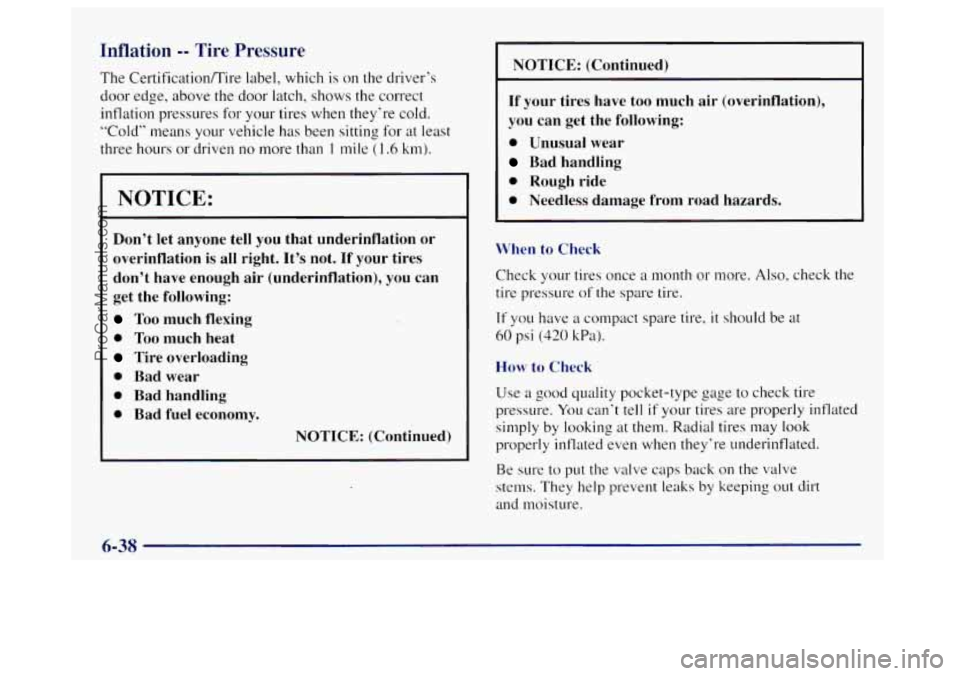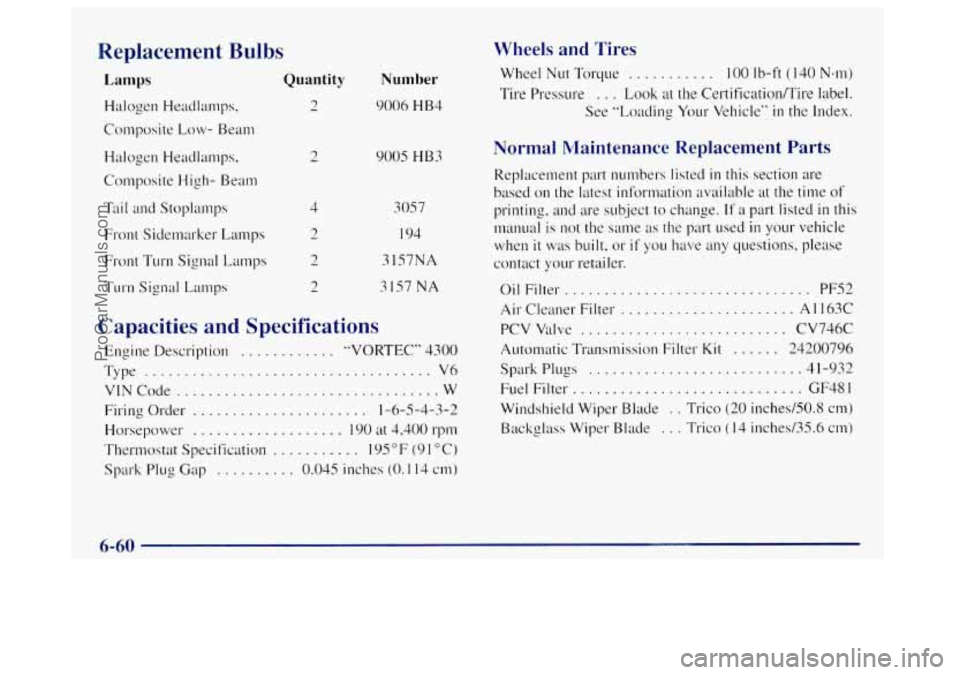tire type OLDSMOBILE BRAVADA 1998 Owners Manual
[x] Cancel search | Manufacturer: OLDSMOBILE, Model Year: 1998, Model line: BRAVADA, Model: OLDSMOBILE BRAVADA 1998Pages: 380, PDF Size: 19.2 MB
Page 166 of 380

Loss of Control
Let's review what driving experts say about what
happens when the three control systems (brakes, steering
and acceleration) don't have enough friction where the
tires meet the road to do what the driver has asked.
In any emergency, don't give up. Keep trying to steer and
constantly seek an escape route or area of less danger.
Skidding
In a skid, a driver can lose control of the vehicle.
Defensive drivers avoid most skids by taking reasonable
care suited
to existing conditions, and by not "overdriving"
those conditions.
But skids are always possible.
The three types
of skids correspond to your vehicle's
three control systems.
111 the braking skid, your wheels
aren't rolling.
In the steering or cornering skid, too
much speed or steering
in a curve causes tires to slip and
lose cornering force. And
in the acceleration skid, too
much throttle causes the driving wheels to spin.
A cornering skid and an acceleration skid are best
handled by easing your foot off the accelerator pedal.
If your vehicle starts to slide, ease your foot off the
accelerator pedal and quickly steer the way you want the
vehicle to
go. If you start steering quickly enough, your
vehicle may straighten out. Always be ready for
a
second skid if it occurs.
Of' course, traction is reduced when water, snow, ice,
c gravel or other material is on the road. For safety, you'll
want to slow down
and ad-just your driving to these
conditions.
It is important to slow down on slippery
surfaces because stopping distance
will be longer and
vehicle control more limited.
While driving on
a surface with reduced traction, try
your best to avoid sudden steering? acceleration OF
braking (including engine braking by shifting to a lower
gear).
Any sudden changes could cause the tires to
slide. You may not realize the surface is slippery
until
your vehicle is skidding. Learn to recognize warning
clues
-- such as enough water, ice or packed snow on
the road
to make a "mirrored surface" -- and slow
down when you have any doubt.
Remember:
Any anti-lock brake system (ABS) helps
avoid only the braking skid.
4-14
ProCarManuals.com
Page 280 of 380

Inflation -- Tire Pressure
The CertificatiodTire label, which is on the driver’s
door edge, above the door latch, shows the correct
inflation pressures for your tires
when they’re cold.
“Cold” means your vehicle has been sitting for
at least
three hours or driven no more than
1 mile (I .6 km).
NOTICE:
Don’t let anyone tell you that underinflation or
overinflation is all right. It’s not. If your tires
don’t have enough air (underinflation), you can
get the following:
Too much flexing
0 Too much heat
Tire overloading
0 Bad wear
0 Bad handling
0 Bad fuel economy.
NOTICE: (Continued)
I NOTICE: (Continued) I
If your tires have too much air (overinflation),
you can get the following:
0 Unusual wear
Bad handling
0 Rough ride
0 Needless damage from road hazards.
When to Check
Check your tires once a month or more. Also, check the
tire pressure
of the spare tire.
If you have a compact spare tire, it should be at
60 psi (420 kPa).
How to Check
Use a good quality pocket-type gage to check tire
pressure.
You can’t tell if your tires are properly inflated
simply by looking at them. Radial tires may
look
properly inflated even when they’re underinflated.
Be sure to put the valve
caps back on the valve
stems. They help prevent leaks
by keeping out dirt
and moisture.
6-38
ProCarManuals.com
Page 282 of 380

When It’s Time for New Tires
I One way to tell when it’s
time .for new tires is to
check the treadwear
indicators, which
will
appear when your tires have
only 1/16 inch (1.6 mm) or
less of tread remaining.
You need a new tire
if any of-. the following statements
are true:
You can see the indicators at three or more places
around the tire.
a You can see cord or fabric showing through the
tire’s rubber.
0 The tire has a bump, bulge or split.
The tire has a puncture, cut or other damage that
can’t be repaired well because
of the size or location
of the damage.
Buying New Tires
To find out what kind and size of tires you need, look at
the Certification/Tire label.
The tires installed on your vehicle when
it was new had
a Tire Performance Criteria Specification (TPC Spec)
number on each tire’s sidewall. When you get new tires,
get ones
with that same ?’PC Spec number. That way
your vehicle
will continue to have tires that are designed
to give proper endurance, handling, speed rating,
traction, ride and other things durinz normal service on
your vehicle.
If your tires have an all-season tread
design. the
TPC number will be followed by an “MS”
(for mud and snow).
If you ever replace yo~~r tires with those not having a
TPC Spec number, make sure they are the same size,
The tread or sidewall is cracked, cut or snagged deep load
range, speed rating and construction type (bias,
bias-belted or radial) as your original tires.
enough to show cord or fabric.
ProCarManuals.com
Page 283 of 380

I CAUTION:
Mixing tires could cause you to lose control while
driving.
If you mix tires of different sizes or types
(radial and bias-belted tires), the vehicle may not
handle properly, and you could have
a crash.
Using tires of different sizes may also cause
damage to your vehicle. Be sure to use the same
size and type tires on all wheels.
It’s
all right to drive with your compact spare
(if you have one). It
was developed for use on
your vehicle.
A CAUTION:
If you use bias-ply tires on your vehicle, the
wheel rim flanges could develop cracks after
many miles of driving.
A tire and/or wheel could
fail suddenly, causing
a crash. Use only radial-ply
tires with the wheels on your vehicle.
Uniform Tire Quality Grading
The following information relates to the system
developed by the United States National Highway
Traffic Safety Administration, which grades tires by
treadwear, traction and temperature performance. (This
applies only to vehicles sold in the United States.) The
grades are molded on the sidewalls of most passenger
car tires. The Uniform Tire Quality Grading system does
not apply to deep tread, winter-type snow tires,
space-saver or temporary use spare tires, tires with
nominal rim diameters of
10 to 12 inches (25 to 30 cm),
or to some limited-production tires.
While the tires available on General Motors passenger
cars and light trucks may vary with respect to these
grades, they must also conform to Federal safety
requirements and additional General Motors Tire
Performance Criteria (TPC) standards.
ProCarManuals.com
Page 286 of 380

NOTICE:
The wrong wheel can also cause problems with
bearing life, brake cooling, speedometer or
odometer calibration, headlamp aim, bumper
height, vehicle ground clearance and tire
clearance to the body and chassis.
See “Changing a Flat Tire” in the Index for
more information.
Used Replacement Wheels
/1 MI CP ““‘3N:
Putting a used wheel on your vehicle is
dangerous. You can’t know how it’s been used or
hotv
far it’s been driven. It could fail suddenly
and cause an accident.
If you have to replace a
wheel, use a new GM original equipment wheel.
Tire Chains
NOTICE:
______
Don’t use tire chains. They can damage your
vehicle because there’s not enough clearance.
Use another type of traction device only if its
manufacturer recommends it for use on your
vehicle and tire size combination and road
conditions. Follow that manufacturer’s
instructions. To help avoid damage to your
vehicle, drive slowly, readjust or remove the
device
if it’s contacting your vehicle, and don’t
spin your wheels.
Appearance Care
Remember, cleaning products can be hazardous. Some
are toxic. Others can burst into flame
if you strike a
match or get them on a hot part of the vehicle. Some are
dangerous if you breathe their fumes in a closed space.
When you use anything from a container to clean your
vehicle, be sure to follow the manufacturer’s warnings
and instructions. And always open your doors or
windows when you’re cleaning the inside.
ProCarManuals.com
Page 302 of 380

Replacement Bulbs
Lamps
Halogen Headlamps,
Composite Low- Beam
Halogen Headlamps.
Composite High- Beam
Tail and Stoplamps
Front Sidemarker Lamps
Front Turn Signal Lamps
Turn Signal Lamps
Quantity
2
2
4
Number
9006 HB4
9005 HB3
305 7
I94
31S7NA
3157
NA
Capacities and Specifications
Engine Description ............ "VORTEC" 4300
Type
.................................... V6
VINCode ................................. W
Firing Order
...................... 1-6-5-4-3-2
Horsepower
................... I90 at 4,400 rpm
Thermostat Specification
........... 1% "F (9 1 "C)
Spark Plug Gap
.......... 0.045 inches (0. I 14 cm)
Wheels and Tires
Wheel Nut Torque ........... 100 Ib-ft ( I40 Nem)
Tire Pressure . , . Look at the Certification/Tire label.
See "Loading Your Vehicle"
in the Index.
Normal Maintenance Replacement Parts
Replacement part numbers listed in this section are
based on the latest information available at the time
of
printing, and are subject to change. If a part listed in this
manual is not the same
as the part used in your vehicle
when
it was built, or if you have any questions, please
contact your retailer.
Oil Filter.
.............................. PFS2
Air Cleaner Filter ...................... A 1 163C
PCV Valve .......................... CV746C
Automatic Transmission Filter
Kit ...... 24200796
Spark P~LI~S
........................... 4 1-932
Fuel Filter ............................. GF48 1
Windshield Wiper Blade . . Trico (20 inchedS0.S crn)
Backglass Wiper Blade
... Trico (14 inched35.6 cm)
6-60
ProCarManuals.com